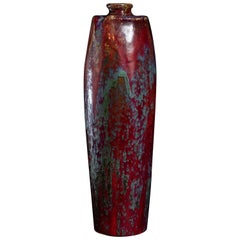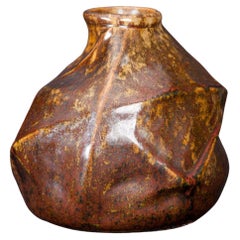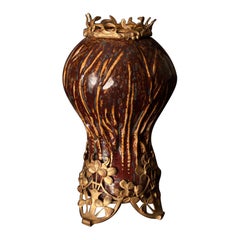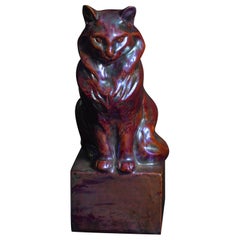Galerie Fledermaus Decorative Objects
to
171
13
33
138
13
129
7
2
108
15
6
3
1
3
2
153
6
4
4
2
140
77
49
39
36
184
158
84
45
19
19
Height
to
Width
to
184
184
184
27
23
17
13
12
Art Nouveau Stoneware Crimson Flambe Vase Pierre-Adrien Dalpayrat
By Pierre-Adrien Dalpayrat
Located in Chicago, US
Shown at Exposition Universelle de Bruxelles, 1910.
PIERRE-ADRIEN DALPAYRAT (1844-1910) After working nearly half his life as an itinerant faience painter and directing production ...
Category
Vintage 1910s French Art Nouveau Vases
Materials
Stoneware
Art Nouveau Asymmetrical Vase by Pierre-Adrien Dalpayrat
By Pierre-Adrien Dalpayrat
Located in Chicago, US
Much fuss is made about Dalpayrat’s signature red, but what many have not realized is that “Dalpayrat Red” refers not simply to a vivid red color glaze but just as often to a nuanced appearance of color resulting from the artist’s technical expertise navigating a complex play of minerals and various firing temperatures. Mossy greens, amber and chestnut tones dance together over Dalpayrat’s blood red base. The result is just as surprisingly modern as the geometric planes forming this asymmetrical vase...
Category
Antique Early 1900s French Art Nouveau Vases
Materials
Stoneware
Art Nouveau Gourd Vase with Brass Mount by Pierre-Adrien Dalpayrat & Marcel Bing
By Marcel Bing, Pierre-Adrien Dalpayrat
Located in Chicago, US
PIERRE-ADRIEN DALPAYRAT (1844-1910) After working nearly half his life as an itinerant faience painter and directing production for commercial porcelain manufacturers, Dalpayrat’s ey...
Category
Antique Early 1900s Art Nouveau Vases
Materials
Brass
Symbolist Cat
By Zsolnay
Located in Chicago, US
"It is easy to understand why the rabble dislike cats. A cat is beautiful; it suggests ideas of luxury, cleanliness, and voluptuous pleasures." - Charles Baudelaire
Iridescence, which changes in every angle of reflected light, is the perfect complement to a cat’s capricious nature. Zsolnay introduced its patented shiny metallic glaze, known as eosin, in 1893. The small family ceramics workshop begun in Pecs, Hungary by Miklos Zsolnay in 1853 had evolved into a world-class ceramics factory by this time. Zsolnay walked away with the Grand Prix at the 1878 World’s Fair in Paris for its art pottery. Under the stewardship of Vilmos Zsolnay...
Category
Antique Early 1900s Hungarian Art Nouveau Animal Sculptures
Materials
Earthenware, Porcelain
$7,000



